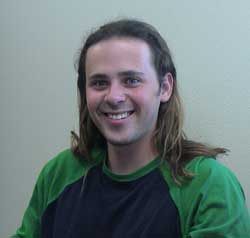A Day in the Life of a Calit2 Undergrad
|
6.16.03 - “We can spend nine hours at a time installing a data logger on a tower, connecting the sensors, and rewriting code to update a software package,” says Alex Revchuk, returning Calit² summer undergrad research scholar and recipient of last summer’s Calit² Undergraduate Prize. “Then we might wait a week to see what data comes in to determine what instruments are misbehaving. For example, an instrument might appear to be detecting ambient light at night. Also, since we use four or five different kinds of sensor to monitor the same thing – largely driven by cost considerations – we need to figure out how to calibrate them so that they measure the same phenomenon in the same way.”
When last we talked a year ago, Alex was spending most of the summer at the Santa Margarita Ecological Reserve near Fallbrook, California, setting up towers and instrumenting them with meteorological instruments to monitor wind speed and direction, temperature, humidity, fuel load (moisture in the plants), and so forth. One of the goals of the research team he’s a member of is to study the interaction between the atmosphere of the desert and that of the ocean and how the topography affects the microclimate, that is, how small perturbations accumulate into larger systems with more significant climatological effects.
The team is busy surveying the topography of the rest of the Santa Margarita river valley westward to extend the wireless sensing infrastructure all the way to the ocean. Topics of concern include where to position the towers for best “line of sight” (for best wireless transmission) and security (since the team expects to instrument a portion of the Camp Pendleton marine base). The team has also been cooperating with a citizen group that has been motivated by a bad fire in Fallbrook to take a more hands-on interest in monitoring and managing their environment.
Guided by Larry Riddle, a former air force technician and now a climatologist in the Scripps Institution of Oceanography (SIO) Climate Research Division, Revchuk has spent much time hand fabricating fixtures to hold instruments on the towers. “Larry does the design, and I build the prototype,” says Revchuk. “After we settled on the right design, I made about 30 cross arms, and 20 of them have been installed.”
The design work can be “discouraging,” says Revchuk, because a lot of things can go wrong. The component pieces might be cut out or drilled wrong so they don’t fit together, and the assembly/disassembly process can be improved continually to simplify transporting equipment to the field. Materials also prove to be a challenge. “We might come up with a sample design from a given material,” says Revchuk, “but the marine techs will then tell us the material will erode in no time!”
So any given piece of equipment might have to be made several times to satisfy all the constraints and the opinions of the participating team members. But the benefit of this process, confirms Revchuk, is that what requires two or three people to get done at the beginning of the project ends up requiring just one in the end, so efficiency is achieved over time.
When it comes to fieldwork, Revchuk has learned “not to plan anything” or at least no more than the next day’s work. “Things can go so wrong,” he says, “or push you in a completely different direction than you anticipated. Or you forget about something that ends up being key to the project, so you try to modify what you’ve done to date to accommodate the forgotten component. I’ve found that flexibility and creativity are key to success.”
Revchuk’s research experience has been broadened by a trip he took, with advisor Dan Cayan, to Sacramento for UC Research Day at the California Senate, which event coincided with the 100th anniversary of SIO. Three or four representatives from each UC campus used the day to discuss their projects and acquaint senators and their staffers with the importance of their research activities for improving the quality of life.
“It came home to me that face time does make a difference,” says Revchuk. “I learned more about research that day than I had by doing it!” he says emphatically. “That is, I learned about what other people think research is -- those that don’t do it, I mean.” Revchuk wants policy making to figure in his future but he insists he needs to better understand the science first.
With one year to go before graduating with a degree in Environmental Systems, Revchuk needs to do a senior project, which he expects will be analysis of the data he has helped create with his field station work – probably related to botany, he says. Then he’s likely bound for graduate school.. “I’ll seek out a program that has the same ideology as UCSD,” he says, “one that’s multidisciplinary and has a focus on remote sensing.”
Media Contacts

